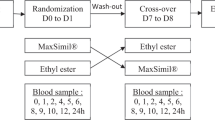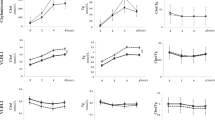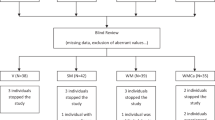Abstract
Background/Objectives:
To compare the efficacy of single versus multiple doses of plant sterols on circulating lipid level and cholesterol trafficking.
Subjects/Methods:
A randomized, placebo-controlled, three-phase (6 days/phase) crossover, supervised feeding trial was conducted in 19 subjects. Subjects were provided (i) control margarine with each meal; (ii) 1.8 g/day plant sterols in margarine with breakfast (single-BF) and control margarine with lunch and supper or (iii) 1.8 g/day plant sterols in margarine divided equally at each of the three daily meals (three times per day).
Results:
Relative to control, end point plasma low-density lipoprotein (LDL) cholesterol concentrations were lower (P<0.05) after consuming plant sterols three times per day but were not different when consumed once per day (3.43±0.62, 3.22±0.58 and 3.30±0.65 mmol/l, control, three times per day and single-BF, respectively). Relative to the control, end point LDL level was 0.21±0.27 mmol/l (6%) lower (P<0.05) at the end of the three times per day phase. Cholesterol fractional synthesis rate was highest (P<0.05) after the three times per day phase (0.0827±0.0278, 0.0834±0.0245 and 0.0913±0.0221 pool/day, control, single-BF and three times per day, respectively). Cholesterol-absorption efficiency decreased (P<0.05) by 36 and 39% after the three times per day and single-BF phase, respectively, relative to control.
Conclusions:
Present data indicate that to obtain optimal cholesterol-lowering impact, plant sterols should be consumed as smaller doses given more often, rather than one large dose.
This is a preview of subscription content, access via your institution
Access options
Subscribe to this journal
Receive 12 print issues and online access
$259.00 per year
only $21.58 per issue
Buy this article
- Purchase on Springer Link
- Instant access to full article PDF
Prices may be subject to local taxes which are calculated during checkout

Similar content being viewed by others
References
AbuMweis SS, Vanstone CA, Ebine N, Kassis A, Ausman LM, Jones PJH et al. (2006). Intake of a single morning dose of standard and novel plant sterol preparations for 4 weeks does not dramatically affect plasma lipid concentrations in humans. J Nutr 136, 1012–1016.
Beaumier-Gallon G, Dubois C, Senft M, Vergnes MF, Pauli AM, Portugal H et al. (2001). Dietary cholesterol is secreted in intestinally derived chylomicrons during several subsequent postprandial phases in healthy humans. Am J Clin Nutr 73, 870–877.
Becker M, Staab D, Vonbergmann K (1992). Long-term treatment of severe familial hypercholesterolemia in children: effect of sitosterol and bezafibrate. Pediatrics 89, 138–142.
Blair SN, Capuzzi DM, Gottlieb SO, Nguyen T, Morgan JM, Cater NB (2000). Incremental reduction of serum total cholesterol and low-density lipoprotein cholesterol with the addition of plant stanol ester-containing spread to statin therapy. Am J Cardiol 86, 46–52.
Bosner MS, Ostlund RE, Osofisan O, Grosklos J, Fritschle C, Lange LG (1993). Assessment of percent cholesterol absorption in humans with stable isotopes. J Lipid Res 34, 1047–1053.
Cleeman JI, Grundy SM, Becker D, Clark LT, Cooper RS, Denke MA et al. (2001). Executive summary of the Third Report of the National Cholesterol Education Program (NCEP) expert panel on detection, evaluation, and treatment of high blood cholesterol in adults (Adult Treatment Panel III). JAMA 285, 2486–2497.
Colgan HA, Floyd S, Noone EJ, Gibney MJ, Roche HM (2004). Increased intake of fruit and vegetables and a low-fat diet, with and without low-fat plant sterol-enriched spread consumption: effects on plasma lipoprotein and carotenoid metabolism. J Hum Nutr Diet 17, 561–569.
Di Buono M, Jones PJH, Beaumier L, Wykes LJ (2000). Comparison of deuterium incorporation and mass isotopomer distribution analysis for measurement of human cholesterol biosynthesis. J Lipid Res 41, 1516–1523.
Doornbos AME, Meynen EM, Duchateau G, van der Knaap HCM, Trautwein EA (2006). Intake occasion affects the serum cholesterol lowering of a plant sterol-enriched single-dose yoghurt drink in mildly hypercholesterolaemic subjects. Eur J Clin Nutr 60, 325–333.
Fletcher B, Berra K, Ades P, Braun LT, Burke LE, Durstine JL et al. (2005). Managing abnormal blood lipids—A collaborative approach. Circulation 112, 3184–3209.
Folch J, Lees M, Stanley GHS (1957). A simple method for the isolation and purification of total lipids from animal tissues. J Biol Chem 226, 497–509.
Friedewald WT, Fredrick DS, Levy RI (1972). Estimation of concentration of low-density lipoprotein cholesterol in plasma, without use of preparative ultracentrifuge. Clin Chem 18, 499–502.
Gylling H, Miettinen TA (1994). Serum-cholesterol and cholesterol and cipoprotein metabolism in hypercholesterolemic NIDDM patients before and during sitostanol ester-margarine treatment. Diabetologia 37, 773–780.
Gylling H, Radhakrishnan R, Miettinen TA (1997). Reduction of serum cholesterol in postmenopausal women with previous myocardial infarction and cholesterol malabsorption induced by dietary sitostanol ester margarine—women and dietary sitostanol. Circulation 96, 4226–4231.
Hallikainen M, Sarkkinen E, Wester I, Uusitupa M (2002). Short-term LDL cholesterol-lowering efficacy of plant stanol esters. BMC Cardiovascular Disordorders 2, 14.
Hallikainen MA, Sarkkinen ES, Gylling H, Erkkila AT, Uusitupa MIJ (2000a). Comparison of the effects of plant sterol ester and plant stanol ester-enriched margarines in lowering serum cholesterol concentrations in hypercholesterolaemic subjects on a low-fat diet. Eur J Clin Nutr 54, 715–725.
Hallikainen MA, Sarkkinen ES, Uusitupa MIJ (2000b). Plant stanol esters affect serum cholesterol concentrations of hypercholesterolemic men and women in a dose-dependent manner. J Nutr 130, 767–776.
Hendriks HFJ, Brink EJ, Meijer GW, Princen HMG, Ntanios FY (2003). Safety of long-term consumption of plant sterol esters-enriched spread. Eur J Clin Nutr 57, 681–692.
Hendriks HFJ, Weststrate JA, van Vliet T, Meijer GW (1999). Spreads enriched with three different levels of vegetable oil sterols and the degree of cholesterol lowering in normocholesterolaemic and mildly hypercholesterolaemic subjects. Eur J Clin Nutr 53, 319–327.
Jakulj L, Trip MD, Sudhop T, von Bergmann K, Kastelein JJP, Vissers MN (2005). Inhibition of cholesterol absorption by the combination of dietary plant sterols and ezetimibe: effects on plasma lipid levels. J Lipid Res 46, 2692–2698.
Jones PJ, Raeini-Sarjaz M, Ntanios FY, Vanstone CA, Feng JY, Parsons WE (2000). Modulation of plasma lipid levels and cholesterol kinetics by phytosterol versus phytostanol esters. J Lipid Res 41, 697–705.
Jones PJH, Ausman LM, Croll DH, Feng JY, Schaefer EA, Lichtenstein AH (1998a). Validation of deuterium incorporation against sterol balance for measurement of human cholesterol biosynthesis. J Lipid Res 39, 1111–1117.
Jones PJH, Howell T, MacDougall DE, Feng JY, Parsons W (1998b). Short-term administration of tall oil phytosterols improves plasma lipid profiles in subjects with different cholesterol levels. Metab-Clin Exp 47, 751–756.
Jones PJH, Leitch CA, Li ZC, Connor WE (1993). Human cholesterol-synthesis measurement using deuterated water—theoretical and procedural considerations. Arterioscler Thromb 13, 247–253.
Katan MB, Grundy SM, Jones P, Law M, Miettinen T, Paoletti R (2003). Efficacy and safety of plant stanols and sterols in the management of blood cholesterol levels. Mayo Clin Proc 78, 965–978.
Kesaniemi YA, Ehnholm C, Miettinen TA (1987). Intestinal cholesterol absorption efficiency in man is related to apoprotein E phenotype. J Clin Invest 80, 578–581.
Kratz M, Kannenberg F, Gramenz E, Berning B, Trautwein E, Assmann G et al. (2007). Similar serum plant sterol responses of human subjects heterozygous for a mutation causing sitosterolemia and controls to diets enriched in plant sterols or stanols. Eur J Clin Nutr 61, 896–905.
Lichtenstein AH, Matthan NR, Jalbert SM, Resteghini NA, Schaefer EJ, Ausman LM (2006). Novel soybean oils with different fatty acid profiles alter cardiovascular disease risk factors in moderately hyperlipidemic subjects. Am J Clin Nutr 84, 497–504.
Maki KC, Davidson MH, Umporowicz DM, Schaefer EJ, Dicklin MR, Ingram KA et al. (2001). Lipid responses to plant-sterol-enriched reduced-fat spreads incorporated into a National Cholesterol Education Program Step I diet. Am J Clin Nutr 74, 33–43.
Mensink RP, Ebbing S, Lindhout M, Plat J, van Heugten MMA (2002). Effects of plant stanol esters supplied in low-fat yoghurt on serum lipids and lipoproteins, non-cholesterol sterols and fat soluble antioxidant concentrations. Atherosclerosis 160, 205–213.
Miettinen TA, Vanhanen H (1994). Dietary sitostanol related to absorption, synthesis and serum Level of cholesterol in different apolipoprotein-E phenotypes. Atherosclerosis 105, 217–226.
Miettinen TA, Vuoristo M, Nissinen M, Jarvinen HJ, Gylling H (2000). Serum, biliary, and fecal cholesterol and plant sterols in colectomized patients before and during consumption of stanol ester margarine. Am J Clin Nutr 71, 1095–1102.
Muldoon MF, Manuck SB, Matthews KA (1990). Lowering cholesterol concentrations and mortality—a quantitative review of primary prevention trials. BMJ 301, 309–314.
Ntanios F (2001). Plant sterol-ester-enriched spreads as an example of a new functional food. Eur J Lipid Sci Technol 103, 102–106.
Ostlund RE, Racette SB, Okeke A, Stenson WF (2002). Phytosterols that are naturally present in commercial corn oil significantly reduce cholesterol absorption in humans. Am J Clin Nutr 75, 1000–1004.
Ostlund RE, Spilburg CA, Stenson WF (1999). Sitostanol administered in lecithin micelles potently reduces cholesterol absorption in humans. Am J Clin Nutr 70, 826–831.
Plat J, Bragt MCE, Mensink RP (2005). Common sequence variations in ABCG8 are related to plant sterol metabolism in healthy volunteers. J Lipid Res 46, 68–75.
Plat J, Mensink RP (2000). Vegetable oil based versus wood based stanol ester mixtures: effects on serum lipids and hemostatic factors in non-hypercholesterolemic subjects. Atherosclerosis 148, 101–112.
Plat J, Mensink RP (2002). Relationship of genetic variation in genes encoding apolipoprotein A-IV, scavenger receptor BI, HMG-CoA reductase, CETP and apolipoprotein E with cholesterol metabolism and the response to plant stanol ester consumption. Eur J Clin Invest 32, 242–250.
Plat J, van Onselen ENM, van Heugten MMA, Mensink RP (2000). Effects on serum lipids, lipoproteins and fat soluble antioxidant concentrations of consumption frequency of margarines and shortenings enriched with plant stanol esters. Eur J Clin Nutr 54, 671–677.
Shin MJ, Lee JH, Jang Y, Lee-Kim YC, Park E, Kim KM et al. (2005). Micellar phytosterols effectively reduce cholesterol absorption at low doses. Ann Nutr Metab 49, 346–351.
Sierksma A, Weststrate JA, Meijer GW (1999). Spreads enriched with plant sterols, either esterified 4,4-dimethylsterols or free 4-desmethylsterols, and plasma total- and LDL-cholesterol concentrations. Br J Nutr 82, 273–282.
Spilburg CA, Goldberg AC, McGill JB, Stenson WF, Racette SB, Bateman J et al. (2003). Fat-free foods supplemented with soy stanol-lecithin powder reduce cholesterol absorption and LDL cholesterol. J Am Diet Assoc 103, 577–581.
Vanhanen HT, Blomqvist S, Ehnholm C, Hyvonen M, Jauhiainen M, Torstila I et al. (1993). Serum-cholesterol, cholesterol precursors, and plant sterols in hypercholesterolemic subjects with different apoe phenotypes during dietary Sitostanol ester treatment. J Lipid Res 34, 1535–1544.
Vanstone CA, Raeini-Sarjaz M, Parsons WE, Jones PJ (2002). Unesterified plant sterols and stanols lower LDL-cholesterol concentrations equivalently in hypercholesterolemic persons. Am J Clin Nutr 76, 1272–1278.
Varady KA, Jones PJH (2006). Decrease in intestinal cholesterol absorption by plant sterols and exercise improves lipid profiles in hypercholesterolemic adults. FASEB J 20, A1025.
Vorlat A, Conraads VM, Vrints CJ (2003). Regular use of margarine-containing stanol/sterol esters reduces total and low-density lipoprotein (LDL) cholesterol and allows reduction of statin therapy after cardiac transplantation: preliminary observations. J Heart Lung Transplant 22, 1059–1062.
Wang YW, Vanstone CA, Parsons WD, Jones PJH (2004). Validation of a single-isotope-labeled cholesterol tracer approach for measuring human cholesterol absorption. Lipids 39, 87–91.
Weststrate JA, Meijer GW (1998). Plant sterol-enriched margarines and reduction of plasma total- and LDL-cholesterol concentrations in normocholesterolaemic and mildly hypercholesterolaemic subjects. Eur J Clin Nutr 52, 334–343.
Acknowledgements
We wish to thank Unilever Research for providing the sterol-enriched and control margarines in-kind. We also thank the study subjects for their enthusiastic participation.
Author information
Authors and Affiliations
Corresponding author
Rights and permissions
About this article
Cite this article
AbuMweis, S., Vanstone, C., Lichtenstein, A. et al. Plant sterol consumption frequency affects plasma lipid levels and cholesterol kinetics in humans. Eur J Clin Nutr 63, 747–755 (2009). https://doi.org/10.1038/ejcn.2008.36
Received:
Revised:
Accepted:
Published:
Issue Date:
DOI: https://doi.org/10.1038/ejcn.2008.36
Keywords
This article is cited by
-
Single frequency intake of α-linolenic acid rich phytosterol esters attenuates atherosclerosis risk factors in hamsters fed a high fat diet
Lipids in Health and Disease (2016)
-
Haematococcus pluvialis as a source of fatty acids and phytosterols: potential nutritional and biological implications
Journal of Applied Phycology (2016)
-
Consumption of a dietary portfolio of cholesterol lowering foods improves blood lipids without affecting concentrations of fat soluble compounds
Nutrition Journal (2014)
-
The cholesterol lowering efficacy of plant stanol ester yoghurt in a Turkish population: a double-blind, placebo-controlled trial
Lipids in Health and Disease (2013)
-
Anticancer effects of phytosterols
European Journal of Clinical Nutrition (2009)



